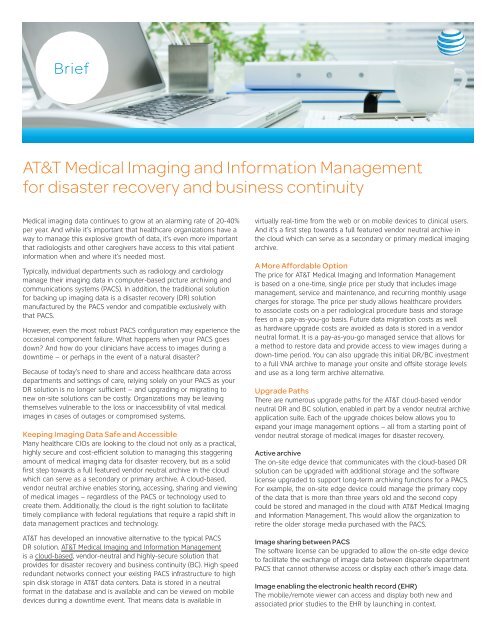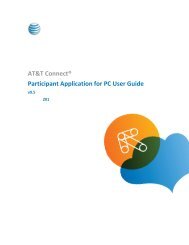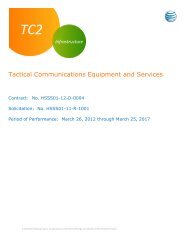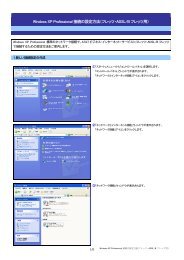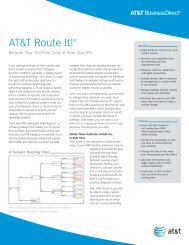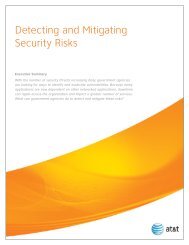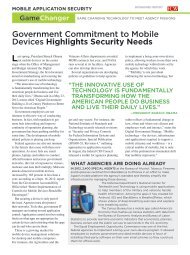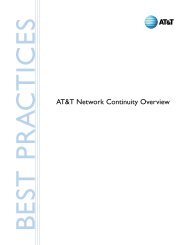Disaster Recovery and Business Continuity - AT&T
Disaster Recovery and Business Continuity - AT&T
Disaster Recovery and Business Continuity - AT&T
You also want an ePaper? Increase the reach of your titles
YUMPU automatically turns print PDFs into web optimized ePapers that Google loves.
BriefAT&T Medical Imaging <strong>and</strong> Information Managementfor disaster recovery <strong>and</strong> business continuityMedical imaging data continues to grow at an alarming rate of 20-40%per year. And while it’s important that healthcare organizations have away to manage this explosive growth of data, it’s even more importantthat radiologists <strong>and</strong> other caregivers have access to this vital patientinformation when <strong>and</strong> where it’s needed most.Typically, individual departments such as radiology <strong>and</strong> cardiologymanage their imaging data in computer-based picture archiving <strong>and</strong>communications systems (PACS). In addition, the traditional solutionfor backing up imaging data is a disaster recovery (DR) solutionmanufactured by the PACS vendor <strong>and</strong> compatible exclusively withthat PACS.However, even the most robust PACS configuration may experience theoccasional component failure. What happens when your PACS goesdown? And how do your clinicians have access to images during adowntime – or perhaps in the event of a natural disaster?Because of today’s need to share <strong>and</strong> access healthcare data acrossdepartments <strong>and</strong> settings of care, relying solely on your PACS as yourDR solution is no longer sufficient – <strong>and</strong> upgrading or migrating tonew on-site solutions can be costly. Organizations may be leavingthemselves vulnerable to the loss or inaccessibility of vital medicalimages in cases of outages or compromised systems.Keeping Imaging Data Safe <strong>and</strong> AccessibleMany healthcare CIOs are looking to the cloud not only as a practical,highly secure <strong>and</strong> cost-efficient solution to managing this staggeringamount of medical imaging data for disaster recovery, but as a solidfirst step towards a full featured vendor neutral archive in the cloudwhich can serve as a secondary or primary archive. A cloud-based,vendor neutral archive enables storing, accessing, sharing <strong>and</strong> viewingof medical images – regardless of the PACS or technology used tocreate them. Additionally, the cloud is the right solution to facilitatetimely compliance with federal regulations that require a rapid shift indata management practices <strong>and</strong> technology.AT&T has developed an innovative alternative to the typical PACSDR solution. AT&T Medical Imaging <strong>and</strong> Information Managementis a cloud-based, vendor-neutral <strong>and</strong> highly-secure solution thatprovides for disaster recovery <strong>and</strong> business continuity (BC). High speedredundant networks connect your existing PACS infrastructure to highspin disk storage in AT&T data centers. Data is stored in a neutralformat in the database <strong>and</strong> is available <strong>and</strong> can be viewed on mobiledevices during a downtime event. That means data is available invirtually real-time from the web or on mobile devices to clinical users.And it’s a first step towards a full featured vendor neutral archive inthe cloud which can serve as a secondary or primary medical imagingarchive.A More Affordable OptionThe price for AT&T Medical Imaging <strong>and</strong> Information Managementis based on a one-time, single price per study that includes imagemanagement, service <strong>and</strong> maintenance, <strong>and</strong> recurring monthly usagecharges for storage. The price per study allows healthcare providersto associate costs on a per radiological procedure basis <strong>and</strong> storagefees on a pay-as-you-go basis. Future data migration costs as wellas hardware upgrade costs are avoided as data is stored in a vendorneutral format. It is a pay-as-you-go managed service that allows fora method to restore data <strong>and</strong> provide access to view images during adown-time period. You can also upgrade this initial DR/BC investmentto a full VNA archive to manage your onsite <strong>and</strong> offsite storage levels<strong>and</strong> use as a long term archive alternative.Upgrade PathsThere are numerous upgrade paths for the AT&T cloud-based vendorneutral DR <strong>and</strong> BC solution, enabled in part by a vendor neutral archiveapplication suite. Each of the upgrade choices below allows you toexp<strong>and</strong> your image management options – all from a starting point ofvendor neutral storage of medical images for disaster recovery.Active archiveThe on-site edge device that communicates with the cloud-based DRsolution can be upgraded with additional storage <strong>and</strong> the softwarelicense upgraded to support long-term archiving functions for a PACS.For example, the on-site edge device could manage the primary copyof the data that is more than three years old <strong>and</strong> the second copycould be stored <strong>and</strong> managed in the cloud with AT&T Medical Imaging<strong>and</strong> Information Management. This would allow the organization toretire the older storage media purchased with the PACS.Image sharing between PACSThe software license can be upgraded to allow the on-site edge deviceto facilitate the exchange of image data between disparate departmentPACS that cannot otherwise access or display each other’s image data.Image enabling the electronic health record (EHR)The mobile/remote viewer can access <strong>and</strong> display both new <strong>and</strong>associated prior studies to the EHR by launching in context.
AT&T Medical Imaging <strong>and</strong> Information Management for disaster recovery <strong>and</strong> business continuity____________________________________________________ 2XDS-I functionalityThe software license can be upgraded to activate XDS-I functionality.This enables the organization to share its DR copy of the data withlocal health information exchanges.Non-PACS data ingestionThe software license can be upgraded to allow the on-site edge device toprovide image acquisition for non-DICOM Data. Non-DICOM data can beconverted to DICOM as well to present itself with the images in a study.Non-DICOM data ingestionOrganizations that want to add non-DICOM data objects to theirpatients’ longitudinal records can also configure the on-site edgedevice to acquire non-DICOM data objects.Information Lifecycle ManagementThe ILM upgrade brings to the organization sophisticated, user-definedretention <strong>and</strong> purge strategies that will use meta data associated witheach study to decide what class of storage should be used to store theimage data <strong>and</strong> when to purge it.VNA upgradeUltimately, any of the upgrade configurations can be brought up to afull hybrid VNA, where the on-site gateway becomes the primary VNAsubsystem <strong>and</strong> the cloud-based DR solution becomes the secondaryVNA subsystem.These various upgrades paths underscore the inherent value of acloud-based vendor neutral DR solution. Compared to the typical PACSvendor’s DR solution, the AT&T cloud-based solution not only has alower total cost of ownership, it has the upside potential that makes ita true investment.Hybrid VNA refers to architecture that combines onsite (customer)<strong>and</strong> offsite (AT&T Medical Imaging <strong>and</strong> Information Management)technologies for virtually seamless vendor-neutral management<strong>and</strong> storage of medical images. A representative configuration isnoted above where a customer’s onsite architecture is comprisedof existing RIS, PACS <strong>and</strong> data centers <strong>and</strong> connected via thenetwork to the AT&T data centers where the data is stored ina vendor neutral DR long term archive. DICOM routing occursbetween the customer’s primary data center <strong>and</strong> the AT&T cloud.Remote <strong>and</strong> mobile viewing of images stored in the AT&T cloud isenabled through the viewing feature of AT&T Medical Imaging <strong>and</strong>Information Management. Similarly, remote <strong>and</strong> mobile viewing ofimages stored in the customer’s primary or secondary data center isactivated through the AT&T provided viewer feature.AT&T Medical Imaging <strong>and</strong> Information Management• Offers a full suite of disaster recovery services for one ormore department PACS• Allows access, sharing, viewing <strong>and</strong> exchange of medicalimaging between disparate PACS• Provides a truly managed, end-to-end service in the market– from network to mobility to security <strong>and</strong> everything inbetween – at a scale unmatched in the industry• Extends the value of customers’ existing network investment<strong>and</strong> helps them meet ongoing <strong>and</strong> growing medical imagingneeds (operationally, clinically, financially)• Is delivered on the AT&T storage platform, which is designedto meet or exceed st<strong>and</strong>ard security guidelines <strong>and</strong> providesaudit <strong>and</strong> encryption of data in transit <strong>and</strong> at rest• Supports an optional viewing application to enable access<strong>and</strong> viewing of medical images from virtually anywhere,<strong>and</strong> thereby represents full image redundancy for clinicalcontinuityTo learn how AT&T can help you build a medical imaging vendor neutral archive, disaster recovery or businesscontinuity strategy, contact your AT&T representative or visit www.att.com/healthcare/miim.03/20/13 AB-2647© 2013 AT&T Intellectual Property. All rights reserved. AT&T <strong>and</strong> the AT&T logo are trademarks of AT&T Intellectual Property.


